Once you try this focaccia bread recipe, you’ll never go back to plain bread! This hearty No-Knead Focaccia bread has tons of airy bubbles and is coated in olive oil and herbs, making every bite full of delicious flavor. And the best part? This easy no knead technique only takes about 5 minutes of hands-on work to make an amazing loaf. This delicious focaccia bread pretty much makes itself!
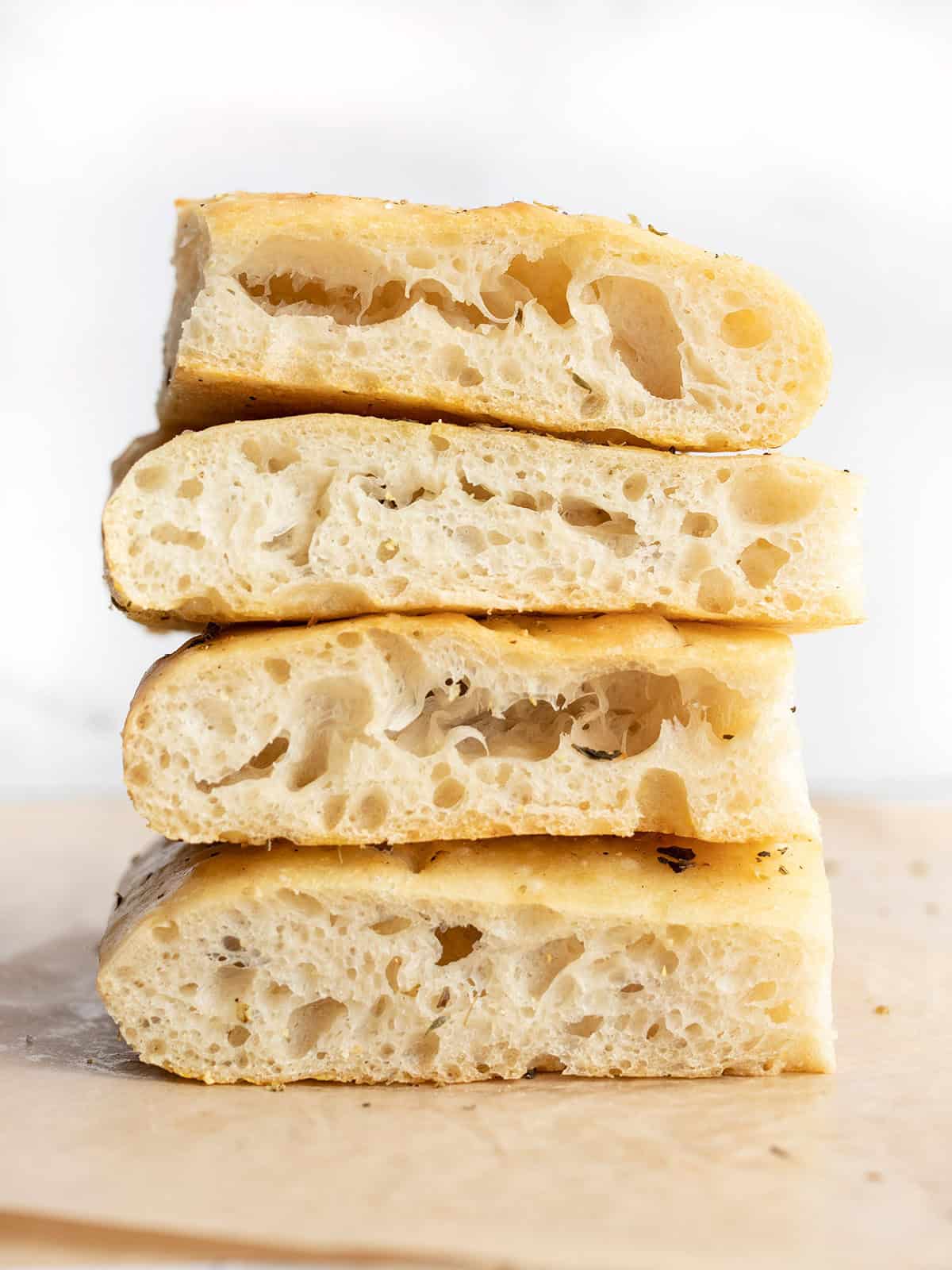
This post contains some affiliate links, which means that we make a small commission off items you purchase at no additional cost to you.
What is Focaccia?
Focaccia bread is an Italian flatbread known for its thick, fluffy texture with plenty of large bubbles. It is often rectangular or circular in shape and is made with high-gluten flour and plenty of olive oil, which gives it a unique texture and flavor. Focaccia can be seasoned with herbs, cheese, or even vegetables and is often used for sandwiches, dipping into soups or sauces, or even as thick base for pizza.
Ingredients for No Knead Focaccia Bread
This super simple no knead focaccia bread recipe only uses a few simple ingredients:
- Flour: Traditionally, focaccia is made with a high-gluten flour that gives it extra strength and a deliciously chewy texture. We crafted this recipe using all-purpose flour to reduce the need to purchase special ingredients. You can use high-gluten flour if you prefer, but the water-to-flour ratio may change slightly.
- Instant Yeast: Because this focaccia recipe uses a no-knead technique, we must use instant yeast which does not need to be bloomed in warm water to activate.
- Salt: Salt helps give the focaccia bread flavor. Without salt, bread can be quite bland and flavorless.
- Water: Water hydrates the flour and helps the yeast activate.
- Olive Oil: Olive oil keeps the focaccia dough from sticking, gives the bread’s crust a wonderful texture, and provides a classic flavor.
- Cornmeal: We use cornmeal to give the bottom crust of the focaccia bread a nice crispy texture, but it is optional.
- Italian Seasoning: A simple Italian seasoning blend is used to give the bread even more flavor, but you can experiment with your focaccia bread with other herbs, spices, cheese, or even vegetables.
Can I Use Whole Wheat Flour?
Yes, you can substitute some of the all-purpose flour for whole wheat flour. Using all whole-wheat flour generally creates a very heavy and dense bread, so I highly suggest using only some, up to 50%, whole wheat flour. You may need to use slightly more water, as whole wheat flour absorbs more moisture than all-purpose flour.
The No Knead Bread Technique
Regular bread baking requires the dough to be kneaded a long time to make the gluten strands line up and form a sort of matrix that gives the dough strength and texture. With no-knead bread, the dough is allowed to ferment overnight. During fermentation enzymes break down the gluten in a process called autolysis, which makes it easier for them to untangle, line up, and form the matrix that usually takes a lot of kneading to form.
An added bonus is that overnight fermentation adds a lot of flavor to the bread. AND, since the yeast has so much time to grow and multiply, you only need to use ¼ tsp yeast, compared to about 2 tsp for a normal loaf of bread! Win-win!
What Do You Serve With No Knead Focaccia?
Focaccia is such a versatile bread! It makes a great side dish with just about any meal, but I think it’s particularly nice with soups and stews. Its hearty texture makes it great for dipping, dunking, and sopping up sauces, stews, and soups. Focaccia bread is also fantastic for sandwiches, especially pressed sandwiches like paninis. You can also use this bread to make pizzas or flatbreads. Simply top it with your favorite cheese, meat, or vegetables and bake again until the cheese is melted and bubbly. Or, if you’re just a bread fanatic like me, slice it into sticks, dip it in some homemade marinara sauce, and call it a day!
How to Store Focaccia Bread
After baking, make sure to allow the focaccia bread to cool completely to room temperature before storing to prevent condensation. Once cooled, you can keep the bread at room temperature in an air-tight container for about two days. If you can’t consume the entire loaf within two days, consider freezing a portion of it for longer storage.
To freeze the focaccia bread, simply let it cool completely until it is room temperature, cut it into slices (whichever size or shape you prefer), then place it in a gallon-sized freezer bag. The frozen no-knead focaccia thaws quickly at room temperature.
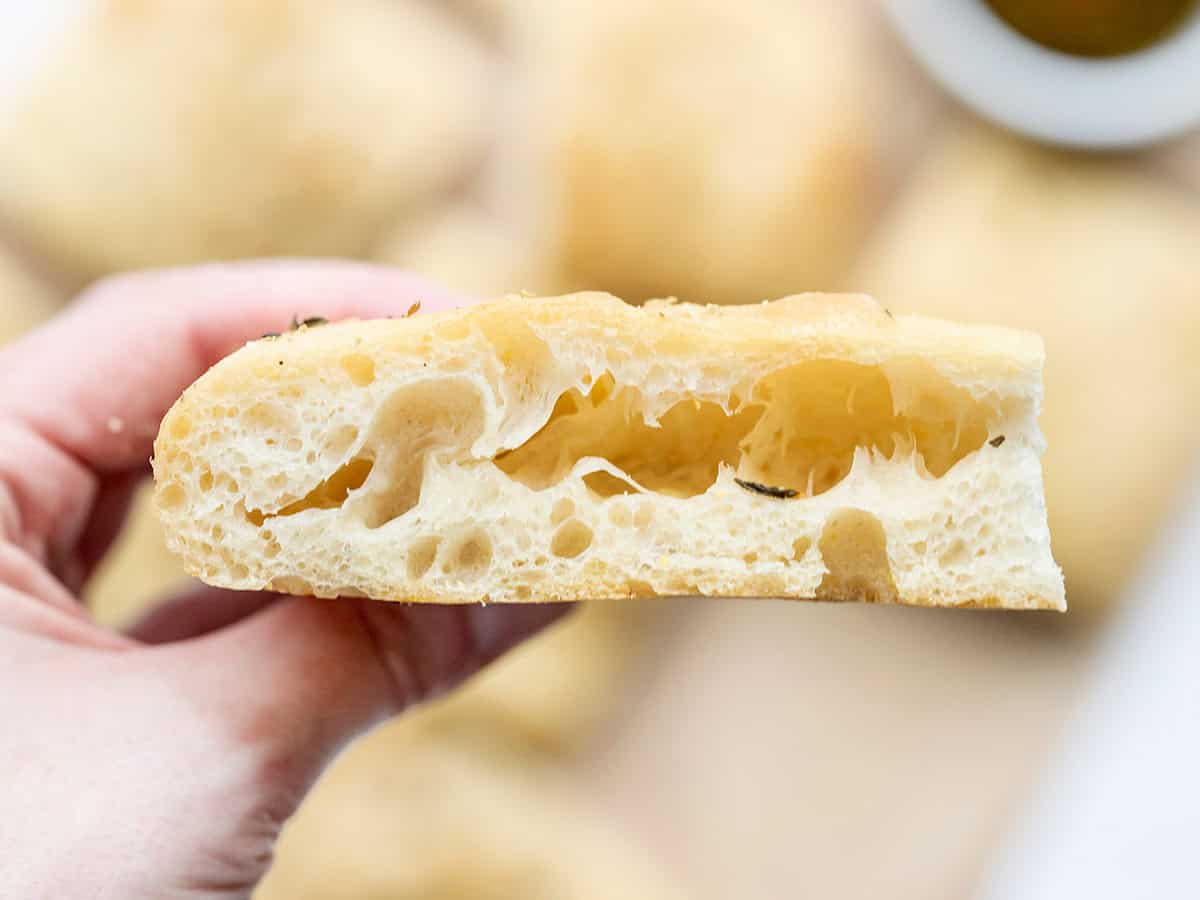
No Knead Focaccia Bread

Ingredients
- 4 cups all-purpose flour ($0.61)
- 1/4 tsp instant yeast ($0.02)
- 1 1/2 tsp salt ($0.03)
- 2 cups water ($0.00)
- 2 Tbsp olive oil, divided ($0.32)
- 2 Tbsp cornmeal ($0.03)
- 1 Tbsp Italian seasoning ($0.30)
Instructions
- The night before, combine the flour, salt and yeast in a bowl. Stir until everything is evenly combined. Add the water and stir until it forms one cohesive, sticky, shaggy ball of dough with no dry flour left on the bottom of the bowl. If there is still dry flour in bowl, add a little water (1-2 Tbsp) until the dough comes together (scroll down to the step by step photos for examples). Loosely cover the bowl and let sit at room temperature for 12-18 hours.
- The next day the dough will be wet, bubbly, and very fluffy. Dust the top of the dough with some flour, then scrape the dough from the sides of the bowl. Turn the dough over on itself a few times until it forms a ball in the center of the bowl.
- Line a baking sheet with foil then drizzle with 1 Tbsp olive oil. Spread the oil to coat the surface of the foil, then sprinkle cornmeal on top of the oil.
- Transfer the dough to the baking sheet. Stretch and pat the dough out into a large rectangle. You may need to dust your hands with flour throughout this process to keep the dough from sticking.
- Drizzle olive oil over the surface of the dough and use a soft brush to spread it evenly over the surface. Sprinkle the Italian seasoning (or any type of herbs) over top. Let the dough rise for another hour.
- Preheat the oven to 425ºF. Using your fingers, press dimples into the risen dough. Bake the focaccia for 20-25 minutes in the preheated oven or until the surface is golden brown. After removing from the oven, allow the focaccia to cool before slicing and serving.
See how we calculate recipe costs here.
Equipment
- Measuring Cups Spoons
- Liquid Measuring Cup
- Enamelware Sheet Pan
Nutrition

How to Make No Knead Focaccia Bread – Step By Step Photos

Start with 4 cups all-purpose flour, ¼ tsp instant yeast, and 1.5 tsp salt. Stir them together until everything is well combined.

Add 2 cups water to the flour mixture. This part will require a little flexibility on your part. You may need to add slightly less or slightly more water depending on the ambient humidity in your home and fluctuations with measuring the flour. I’ll show you what to look for in the next photos.

Stir the water into the flour until it forms a ball of sticky dough and there is no more dry flour left on the bottom of the bowl. In the photo above, the dough is too dry. You can see dry flour on the bottom of the bowl and the dough ball is not cohesive. If this is your dough, add a tablespoon or two more water.

Your dough should look like this. Sticky, but not slimy or shiny, and no dry flour on the bottom of the bowl. This style of dough is much more wet than traditional bread dough. Cover the bowl loosely and allow it to sit at room temperature for 12-18 hours.

After 12-18 hours the dough will look very bubbly and large, like this. Am I weird for thinking that’s gorgeous??

Sprinkle a little flour over the dough to keep your hands from sticking and pull the dough from the sides of the bowl. Turn the dough over onto itself a few times until it forms a sort of ball. Keep your hands well floured as you do this.

This is what the dough looks like after I folded it onto itself a few times. The gluten matrix is well developed. You can tell by how smooth it is and the air bubbles trapped right under the surface.

Line a baking sheet with foil, then drizzle 1 Tbsp olive oil over the surface. Use your hands to spread the oil to evenly coat the surface of the foil, then sprinkle about 2 Tbsp cornmeal over the oil.

Transfer the ball of dough to the prepared baking sheet and press and stretch it out until it fills the entire baking sheet. Drizzle one more tablespoon of olive oil over the surface of the dough, then sprinkle 1 Tbsp Italian seasoning over the surface (you can use a mix of basil, oregano, and red pepper if you don’t have Italian seasoning).

Let the dough rise for one hour (or a little more if your ambient room temperature is on the cool side). When you get close to the end of the rise time, begin preheating your oven to 425ºF. Use your fingers to make dimples all over the dough.

Once the focaccia has risen and the oven is fully preheated, transfer the baking sheet to the oven and bake the focaccia bread for 20-25 minutes, or until it is nicely golden brown on top.

Look at those gorgeous bubbles!

Let the focaccia bread cool before slicing. You can slice it into 12 squares, or into strips, which are nice for dipping and dunking into soups and stews.


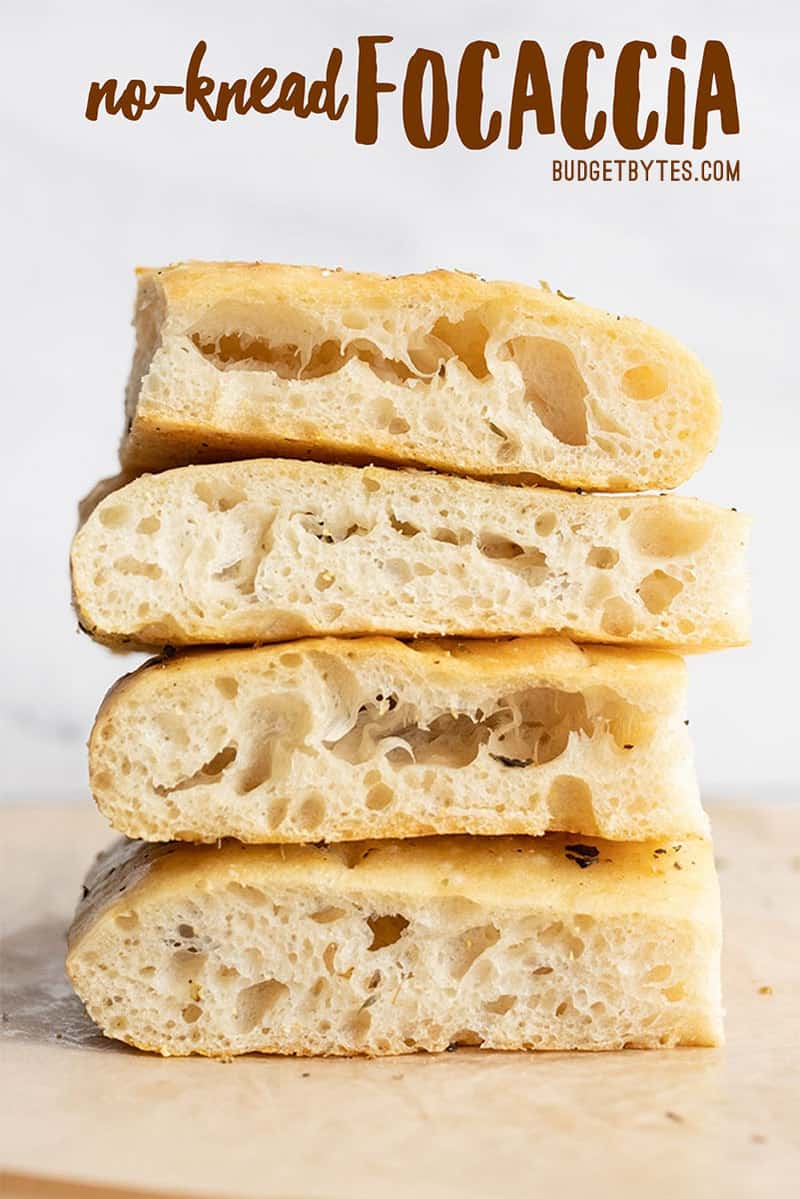
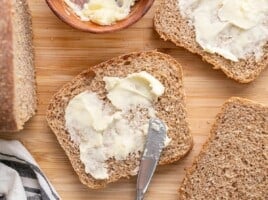
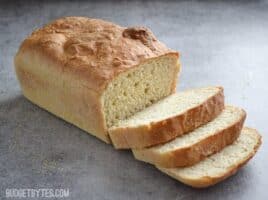
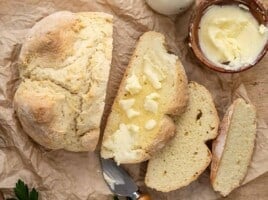
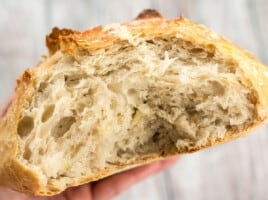
What is the cornmeal for? If it can’t be left out, are there any things that could be substituted for it? I don’t use cornmeal for anything else, so it feels wasteful to buy some just for this recipe.
That should work fine. The cornmeal doesn’t go into the dough, so you could even do without it if you want :) It just helps keep the dough from sticking to the baking sheet (although the oil is sufficient on its own) and it helps give a nice texture to the bottom.
This recipe turned out FANTASTIC! I’m not a bread baker and figured this would be a good place to start, and oh boy we were not disappointed. It has such a nice crusty exterior with a really light, bubbly and airy interior. I played around with the spices on top a bit and went with a blend of rosemary, thyme, oregano, paprika, chunky salt, and cracked pepper. I’m so glad we have more in the freezer because this stuff will not last long :)
Can I use less salt?
I wondered the same thing. I compared this with Budget Bytes regular no-knead bread, which uses 1/2 tsp salt to 3 cups flour. I think the focaccia would rise and bake fine, but the flavor would be quite different if you reduced the salt dramatically.
I think if you look at the recipe again for the regular no-knead bread that it calls for 1/2 a tablespoon of salt, not half a teaspoon. A tablespoon usually measured as 15ml, and a teaspoon 5ml. Making one and a half teaspoons equivalent to half a tablespoon – 7.5ml.
I was also surprised at how much salt was required, it seems a lot and I tried it with less (1 tsp), but the flavor of the bread is so much better if you follow the recipe!
This was amazing. I mixed it up last evening and them cooked it today. Had it with so!e potato corn chowder. The whole house smelled great.
I have traditional yeast, not instant. Can I use traditional yeast instead and do I need to make any modifications?
Not for this recipe, unfortunately. Active dry must be proofed in hot water before adding to the recipe, whereas instant yeast can be added to the flour dry, without any activation by hot water. In general, you can use instant yeast in place of active dry in any recipe, but you can not use active dry in place of instant in recipes where it is not proofed first in hot water. I hope that made sense! :)
If you did proof the traditional yeast in the 2 cups water called for in the recipe (and the water was warm enough at the time of proofing and then left to cool to room temp, to continue as normal with the recipe), would it still work?
Yes that will be okay!
Looks really nice. How was the top? Was it a little crunchy or it was soft?
Just finished making this last night and it was SO GOOD! I had never made bread before and I was nervous, but this recipe was super easy! The bread was so nice and fluffy! I added some kalamata and green olives on top before I baked it and it was delicious. I served it with some sausage and peppers. Will definitely make again!
Could you add the quantities in metric system for us Europeans :)
I wish I could do metrics, but it would just be too difficult to try to measure everything out while cooking. Some ingredients can be simply converted with math because of volume to weight conversions.
It looks so yummy! I’ll have a small party this weekend and I will add this recipe to our party menu. Thanks for the instruction.
My yeast is nearly expired – but I *have* some! So, my dough is sitting in a bowl on the back of the stove right now – and I am hopeful that tomorrow’s lunch will include a lovely foccacia bread :D
Thank you for posting this!
Came back to say – I left my dough overnight and nearly forgot about it :) I mixed it up at 7pm Friday night, and it wasn’t until 5:30pm Saturday evening that I got back to it :D
The hardest part was stretching and pressing the dough out to fit my pan – the foil pulled off the pan and I never did get the dough to be the same thickness across the whole pan.
HOWEVER – it baked up beautifully, made my house smell AMAZING and came out perfect! This is a keeper and I will be making it again!
2 questions—
What do I loosely cover it with overnight? A towel? Cling wrap?
Is it necessary to use the foil, or can I bake directly on baking sheet? Would parchment paper work instead of foil?
Thank you — can’t wait to try this recipe : )
Hi Joan! Yes you can use a light towel such as a tea towel or flour sack towel. You could use cling wrap too but you don’t want it to stick to the dough. You definitely can use parchment in lieu of foil. Enjoy!
I’d also love to know the size of your baking sheet pan. This looks so good and easy to come together!
Thanks Bonnie! It’s an 11×13 baking sheet. Enjoy!
Looks good! What size was your baking sheet pan?
Do I use warm water or room temp wster for this recipe?
Room temperature water. :)
Fine salt or kosher salt? There’s a big difference in salinity!
It’s fine salt. :)